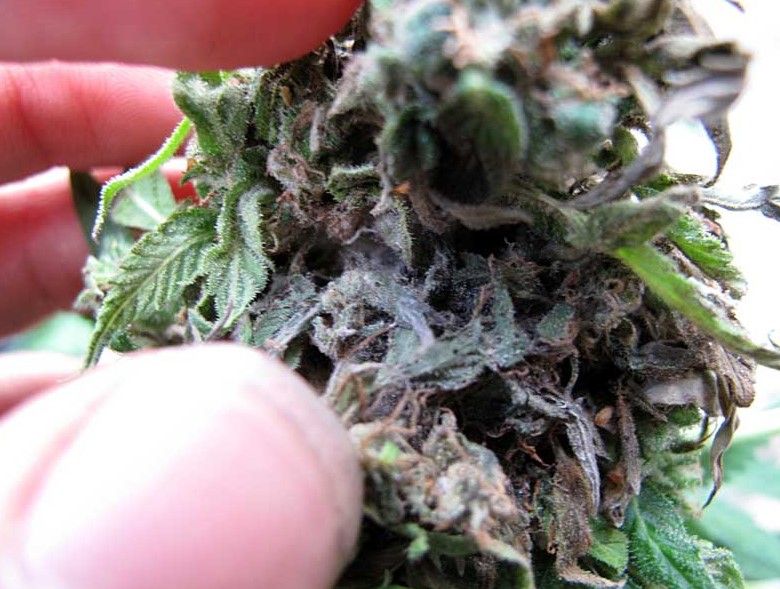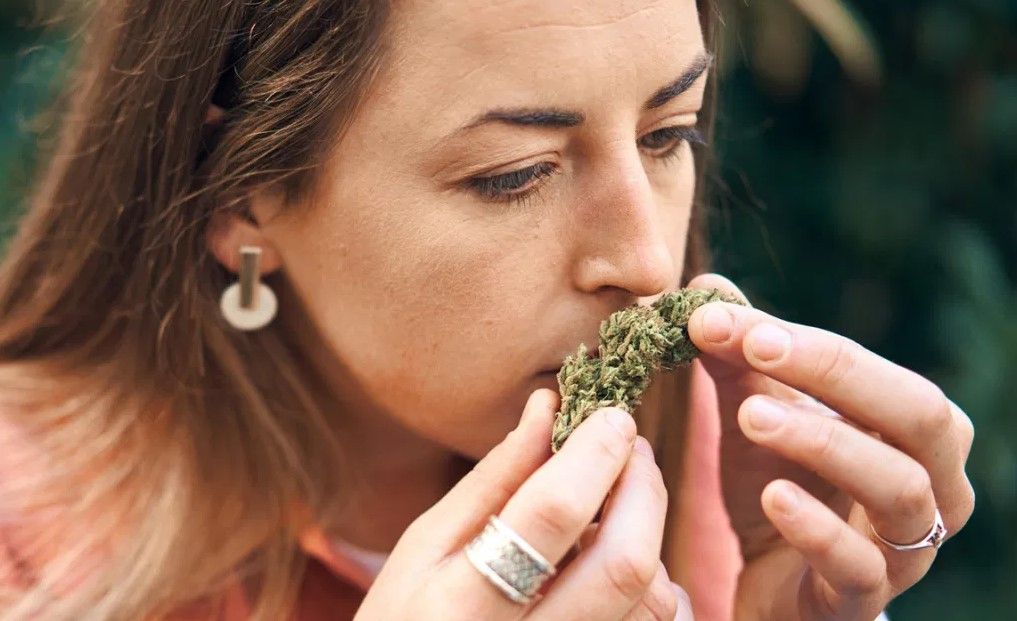Don’t expose yourself to the horror of finding your beloved cannabis garden decimated by mold and having to kneel before it screaming, “Damn you! Damn you, you filthy mold!” Weed mold is a serious problem that many stoners face; read this article now so that one day it may save your life.
Spending months of effort on a grow only to discover it has been spoiled by mould or bud rot during its final stages is incredibly disheartening. Even worse, smoking something that has gone bad can cause serious health issues – so it’s essential for all growers and smokers to understand how to identify and prevent moldy weed. Caring for your plants isn’t just about the end result; taking the proper precautions also helps keep your lungs safe!
Red Alert: Bud Mold
Don’t be alarmed, but in our estimation – Moldy Weed is the greatest menace to marijuana gardens. Out of all potential calamities and pests Mother Nature can shove upon us, nothing is as devastating or deadly than Cannabis Mold. The grief it brings even a seasoned stoner cannot go ignored – It’s just that unforgiving!
If you’ve been unfortunate enough to find yourself in possession of a moldy bag, it’s not time to make excuses – but rather discard the weed immediately. Mold is more than just an unwanted addition to your stash; consuming any form of this toxic waste through smoking, eating or vaping exposes you to thousands and potentially tens of thousands of hazardous microbial spores.
If you’re fortunate, the foul taste will deter you from indulging too much and subsequently allow you to discard your contaminated weed stash swiftly without any adverse effects.
Imagine the worst-case situation: you get hospitalized with a severe lung infection, and your only visitor is an unscrupulous anti marijuana lobbyist who wants to write about the first cannabis related death in history.
Research on the Dangers of Smoking Mouldy Weed
While uncommon, there is clear evidence that avoiding mouldy marijuana can have positive benefits for your overall health. According to Gargani’s 2011 study, two deaths due to lung infections were attributed to the presence of Aspergillus fumigatus in their cavities. Research does not currently suggest whether this type of fungus survives burning cannabis; however, it could be possible that inhaling airborne mold from the plant itself caused these fatalities.
To allay your anxieties, these studies were conducted on two heavy smokers who puffed up to 20 joints each day for several decades. Thus, it is unlikely that one mouldy joint would be deadly to you. The research further proves that the potential harm of stale marijuana goes beyond folklore and fiction.
How To Detect A Moldy Weed When You’re Buying
If you’re smart enough to acquire your cannabis from reliable sources such as a marijuana dispensary, coffee shop or club, don’t assume that it will be free of mold. Mold needs nothing more than ideal growing conditions to thrive–even after harvest! So even if you purchase high-quality weed from an expert source, there’s still cause for concern.
Inaccurate curing or storing your cannabis by the retailer can quickly transform a jar of weed into an unappealing, furry mess covered in fungus. Failure to maintain dryness results in mold and other fungi that render the marijuana unusable.
Even though it is slow and meticulous, drying with brown paper bags alone isn’t enough – the curing process must be done correctly. Too often, this step does not go as planned.
An unappealing feature of moldy marijuana is its rank stench, which can range from mildew to hay. To be safe, it’s best practice to give your stash a quick sniff before purchase – in addition to the customary visual inspection.
Most premium cannabis retail establishments do not welcome customers getting freely tactile with their marijuana selection.
If you get the go-ahead from your budtender, be sure to sample a spliff or pipe hit; after all, it’s always best to experience the full flavor and sensation with a hands-on touch and taste test. If permitted, take advantage of this opportunity – free hits are among the greatest!
How To Spot Mouldy Weed
When you’re trying to figure out if your cannabis is moldy, there are certain indicators that require a deeper look as they can be quite similar to the properties of a pristine bud. Keep an eye out for these telltale signs and you’ll know whether or not it’s safe to smoke!
Signs include:
- Greyish-white coating: subtly “dustier” to the shiny, resinous covering of trichomes
- Beneath a blacklight (UV), spores will emanate a green hue
- Cat-urine-like smell
- Black or dark green spots on the bud
- White, grey, yellow, or brown fuzz
- White, grey, or black web-like substance
- Spider mite webbing or mildew (these look the same; both are bad)
- Powdery mildew: can resemble dusted kief, but looks drier and dustier
- Slime
If you’re wondering whether your buds are healthy and ready to smoke, there are a few indicators that can help guide you.
- Rich colours (under normal light)
- Pungent “weedy” aromas—not repulsive
- Sticky, but free from strange substances
- Free of patches of growth
With our guide to cannabis tasting and recognizing between quality weed and bad cannabis, you’ll gain the understanding required to identify sub-par buds!
Is there any way to get rid of mould from buds? Unfortunately not; if it’s already developed, it’s generally too late. Thankfully, our bodies have adapted over the years to detect and repel anything that is contaminated by mould. So if your eyes or nose are warning you something doesn’t seem right with a certain bud sample, listening to them would be wise for sure!

How To Detect Moldy Weed When You’re Growing
The earlier you can detect mold on your plants, the better chance you have at rescuing your entire crop. Unfortunately, if one of them is affected, it has to go – no exceptions! But if you act quickly enough and get rid of the infected plant before it spreads its spores to any others, then there’s a good possibility that the other ones will survive unscathed.
Investing in a pocket microscope that is cost-efficient can be incredibly beneficial for discovering fungal issues early on. If your buds are completely overrun, then the spores have most likely been passed to other plants and you’ve lost the battle against infection. Using a microscope while inspecting any signs of contamination could help identify just one case before it has had time to spread rapidly.
As the saying goes, prevention is better than cure – and this holds especially true when it comes to avoiding mould on cannabis plants. Ensuring that you have a basic understanding of temperature, humidity and optimal conditions during each stage of plant growth will give your crops the best protection against potential fungal infections.
How To Prevent and Detect Mouldy Weed When Drying, Curing, and Storing
Keeping your buds in prime condition from harvest to smoke is of utmost importance; if you don’t, mould will swiftly take over. Only upon lighting up a joint can you be certain that it won’t become susceptible to this unwelcome intruder. Establishing a precise routine for trimming, drying, curing and storing your weed guarantees its freshness until the moment of consumption.
With the right precautions, you can ensure that your buds stay safe from mold’s relentless hunger.
No matter which step of the post-harvest process you may be in, there are several key indicators to look out for. Is it rough or smooth to the touch? Do any white, fuzzy patches appear on its surface that don’t belong? Does it have a putrid smell emanating from it? By being aware and alert during all stages of post-harvesting, you can ensure quality assurance!
Ask yourself these questions to identify any health issues with your buds and hopefully prevent mold. It’s the ideal time for a thorough inspection, since you’ll already be handling them. Get up close and personal – this is your chance!
To protect against mould, here are some simple steps you can take.
Trimming
When it comes to caring for your crops, you have two approaches at your disposal: wet trimming and dry trimming. Wet trimming is typically better suited to growers who are concerned with mould prevention, as it involves the direct cutting of buds soon after harvesting. Dry Trimming on the other hand takes place further down the line when buds have been sufficiently dried over a period of time. Whichever way you decide to go about cultivating yours plants, both methods can help ensure that quality results!
- Carefully prune back any excess foliage without snipping the flowers, and make sure to give them a nice manicure.
- Not only does trimming the plant enhance its aesthetic, it also decreases the chances of fungi developing. The leaves and stems contain a lot of moisture which can impede on the drying/curing process, granting fungi an opportunity to thrive.
- Besides preventing mould, wet trimming decreases the amount of trichomes lost due to shaking or friction. Conversely, dry trimming carries a greater risk as it causes the trichomes to become more fragile and liable to drop off.
Drying
The drying process is critical to ensuring that mould does not affect your buds. If conducted correctly, this step will drastically reduce the risk of mould infestation.
- Dry your buds for 7–12 days (or more if they are very dense).
- Create a dark setting with sufficient air circulation and keep the relative humidity between 45–55%.
- If you snap the stems on each bud with pressure, instead of bending them, then that’s a sign to start drying and curing them.
Curing
After gauging 10-15% of the total weight from water droplets, it’s necessary to cure and thoroughly dry your buds.
- Place your weed in airtight jars in a dark, dry environment.
- Keep a keen eye open for those small white spots right now. Although they may appear insignificant, it could be an indication that mould has taken up residence in your home.
- To maintain freshness and prevent the formation of mould, be sure to “burp” your jars once daily by opening them for a few minutes. This process of circulating air helps keep your buds in optimal condition.
- Continue this process for at least 2–8 weeks.
- A longer cure will result in greater expression of terpenes and tastier buds!
Storage
In conclusion, proper storage ensures that your buds stay free of mould until you’re ready to enjoy them.
- Keep your buds in airtight containers or stash boxes.
- Maintain a dark, dry, and cool environment—just below 25°C is perfect.
- A humidity of 58–62% will help to prevent mould while stopping the weed from drying out too much.
- Avoid fridges and freezers!
- Use humidity packs like Moisture Fighters to monitor and maintain ideal humidity levels.
- As long as your stash is properly dried, cured and stored, you won’t need to worry about taking care of it while it’s in its resting place.
Despite proper storage, cannabinoids will deteriorate and transform with the passage of time. While marijuana has an extended shelf life, it is not imperishable.
The Consequences of Moldy Weed for Ganjapreneurs, Growers, & Stoners
Even a single mold-infested plant has the potential to spread its spores throughout your entire grow op—from other plants, soil, and containers. If you’re cultivating indoors, then it’s crucial that the area is thoroughly sanitized in order to eliminate any lingering spores from ruining future yields. A clean environment is essential for successful harvests!
It’s a chaotic situation that no cannabis cultivator desires to encounter- fighting against mold growth with various treatments, knowing the plant casualty rate will be alarmingly high in any case. Thus, it is essential for the responsible grower to stay mindful of this menace from seed to spliff.
Moldy weed is noxious, and any cannabis-user should refuse to consume it. In the same vein, absolutely no cultivator or ganjapreneur should ever trade in moldy marijuana products – such practices are surefire ways to ruin your reputation!
It is essential for stoners to stay away from contaminated marijuana, and the only way to guarantee that you’re getting clean weed is by routinely examining it before spending money.
To cultivate the finest organic herbs, we suggest adding liquid silica in your garden to strengthen vegetation as well as using aerated and top-notch quality soil that allows proper drainage.

